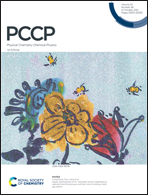Valence tautomeric transformation in the [CrCo] compound: exploration of cooperative interactions
Abstract
A crystal containing the heterometallic Cr-ligand-Co cluster with an unpaired electron on the ligand as a structural unit is examined. The developed model which describes the magnetic and polarizability characteristics of this crystal takes into account that the electron residing on the ligand can be transferred to the Co-ion, thus converting the diamagnetic ls-CoIII ion into the paramagnetic hs-CoII one. Since this transformation is accompanied by electron density redistribution and elongation of the Co–N bond lengths, the vibronic interaction of the Co-ion with totally symmetric displacements of the nearest surroundings and cooperative dipole–dipole and electron-deformational interactions are accounted for as well. The exchange interactions between the CrIII ion and the electron localized on the ligand as well as in the CrIII-hs-CoII pair are also included in consideration; the parameters of these interactions are estimated within the framework of the DFT method. Bistability in the magnetic and polarization characteristics is predicted for certain strengths of intra- and intercluster interactions in the crystal under study. Within the framework of the developed approach an explanation of the observed magnetic properties of the [Cr(SS-cth)(Co(RR-cth)(μ-dhbq))](PF6)2Cl crystal is given.
![Graphical abstract: Valence tautomeric transformation in the [CrCo] compound: exploration of cooperative interactions](/en/Image/Get?imageInfo.ImageType=GA&imageInfo.ImageIdentifier.ManuscriptID=D1CP03209G&imageInfo.ImageIdentifier.Year=2021)
- This article is part of the themed collection: 2021 PCCP HOT Articles


 Please wait while we load your content...
Please wait while we load your content...